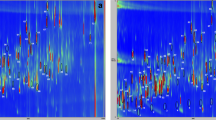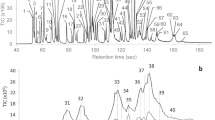Abstract
Purpose
This article aims to investigate the use and benefits of using comprehensive two-dimensional gas chromatography (GC × GC) and structure–activity relationship modeling for screening and prioritization of organic contaminants in complex matrices. The benefit of applying comprehensive screening techniques to samples with high organic contaminant content is primarily that compounds with diverse physicochemical properties can be analyzed simultaneously. Here, a heavily contaminated industrial area was surveyed for organic pollutants by analyzing soil, sediment, and surface water samples. The hazard of the pollutants were ranked using SARs.
Material and methods
The water samples were liquid–liquid extracted using dichloromethane and directly analyzed by GC × GC–time-of-flight mass spectrometry (GC × GC–TofMS). Soil and sediment samples were extracted with dichloromethane in an ultrasonic bath and subjected to gel permeation chromatography to eliminate lipids and humic matter. The low molecular weight fraction was then analyzed with GC × GC–TofMS.
Results and discussion
More than 10,000 components were found in each sample, of which ca. 300 individual compounds were unambiguously identified using the National Institute of Standards and Technology mass spectra library and authentic reference standards. Alkanes, polycyclic aromatic hydrocarbons, and phthalates were generally the most abundant and were found in all matrices. In contrast, chlorinated compounds such as chlorophenols, biphenyls, and chlorinated pesticides were only detected in samples from a few hotspot regions. The toxicities of the most frequently detected compounds and of the compounds detected at the highest concentrations in samples from hotspot regions were estimated by ecological structure–activity relationships. The ratio of the measured concentration to the predicted toxicity level was then calculated for each compound and used for an initial risk assessment in order to prioritize compounds for further transport and fate modeling, complementary measurements, and more advanced risk assessments.
Conclusions
The advantage of using of GC × GC–TofMS for preliminary screenings of contaminated areas was evaluated at a polluted area in northern Sweden. The area was found to carry organic pollutants such as polyaromatic hydrocarbons, aliphatic hydrocarbons, polychlorinated biphenyls, phthalic compounds, and many chlorinated pesticides. Preliminary risk assessments indicate which compounds to use for subsequent remediation experiments based on their availability on the site or toxicity.


Similar content being viewed by others
References
Adahchour M, Beens J, Vreuls RJJ, Brinkman UAT (2006) Recent developments in comprehensive two-dimensional gas chromatography (GC × GC)—IV. Further applications, conclusions and perspectives. Trac-Trends Anal Chem 25(8):821–840
Ahling B, Jensen S (1970) Reversed liquid-liquid partition in determination of polychlorinated biphenyl (PCB) and chlorinated pesticides in water. Anal Chem 42(13):1483–1486
Berset JD, Holzer R (1999) Quantitative determination of polycyclic aromatic hydrocarbons, polychlorinated biphenyls and organochlorine pesticides in sewage sludges using supercritical fluid extraction and mass spectrometric detection. J Chromatogr A 852(2):545–558
Braune BM, Outridge PM, Fisk AT, Muir DCG, Helm PA, Hobbs K, Hoekstra PF, Kuzyk ZA, Kwan M, Letcher RJ, Lockhart WL, Norstrom RJ, Stern GA, Stirling I (2005) Persistent organic pollutants and mercury in marine biota of the Canadian Arctic: an overview of spatial and temporal trends. Sci Total Environ 351:4–56
Chromedia (2011) Chromedia chromatography knowledge base. http://www.chromedia.org/chromedia. Accessed 20 May 2011
Convention SotS (2011) Stockholm convention on persistent organic pollutants http://chm.pops.int/default.aspx
Dincutoiu I, Gorecki T, Parker BL (2003) A novel technique for rapid extraction of volatile organohalogen compounds from low permeability media. Environ Sci Technol 37(17):3978–3984
EPA US (2009) Ecological structure activity relationships http://www.epa.gov/oppt/newchems/tools/21ecosar.htm. Accessed 20 May 2011
Huang HP, Bowler BFJ, Oldenburg TBP, Larter SR (2004) The effect of biodegradation on polycyclic aromatic hydrocarbons in reservoired oils from the Liaohe basin, NE China. Org Geochem 35(11–12):1619–1634
Lacorte S, Ikonomou MG, Fischer M (2010) A comprehensive gas chromatography coupled to high resolution mass spectrometry based method for the determination of polybrominated diphenyl ethers and their hydroxylated and methoxylated metabolites in environmental samples. J Chromatogr A 1217(3):337–347
Law RJ, Alaee M, Allchin CR, Boon JP, Lebeuf M, Lepom P, Stern GA (2003) Levels and trends of polybrominated diphenylethers and other brominated flame retardants in wildlife. Environ Int 29(6):757–770
Mao D, Lookman R, Van de Weghe H, Weltens R, Vanermen G, De Brucker N, Diels L (2009) Combining HPLC-GCXGC, GCXGC/ToF-MS, and selected ecotoxicity assays for detailed monitoring of petroleum hydrocarbon degradation in soil and leaching water. Environ Sci Technol 43(20):7651–7657
Pena MT, Pensado L, Casais MC, Mejuto MC, Cela R (2007) Sample preparation of sewage sludge and soil samples for the determination of polycyclic aromatic hydrocarbons based on one-pot microwave-assisted saponification and extraction. Anal Bioanal Chem 387(7):2559–2567
Pena MT, Casais MC, Mejuto MC, Cela R (2008) Development of a matrix solid-phase dispersion method for the determination of polycyclic aromatic hydrocarbons in sewage sludge samples. Anal Chim Acta 626(2):155–165
Penetra A, Cardoso VV, Ferreira E, Benoliel MJ (2010) Solid-phase extraction and gas chromatography-tandem mass spectrometry method for the simultaneous determination of several pesticides in water. Water Sci Technol 62(3):667–675
Perez S, Guillamon M, Barcelo D (2001) Quantitative analysis of polycyclic aromatic hydrocarbons in sewage sludge from wastewater treatment plants. J Chromatogr A 938(1–2):57–65
Schoenmakers PJ, Oomen J, Blomberg J, Genuit W, van Velzen G (2000) Comparison of comprehensive two-dimensional gas chromatography and gas chromatography-mass spectrometry for the characterization of complex hydrocarbon mixtures. J Chromatogr A 892(1–2):29–46
Schussler W (1990) Automatic-measurement of bentazone and phenoxy acid herbicides by HPLC with 3 different detectors. Chromatographia 29(1–2):24–30
Trably E, Delgenes N, Patureau D, Delgenes JP (2004) Statistical tools for the optimization of a highly reproducible method for the analysis of polycyclic aromatic hydrocarbons in sludge samples. Int J Environ An Ch 84(13):995–1008
USEPA (1986) Test methods for evaluating solid wastes. EPA method SW 846. United States Environmental Protection Agency (USEPA)
Walker CH (2001) Organic pollutants an ecotoxicological perspective. Taylor & Francis, New York
Wang ZS, Stout SA (2006) Oil spill environmental forensics: fingerprinting and source identification. Elsevier, New York
Acknowledgments
The Kempe Foundation is greatly acknowledged for their financial support of this study.
Author information
Authors and Affiliations
Corresponding author
Additional information
Responsible editor: Jean-Paul Schwitzguébel
Electronic supplementary material
Below is the link to the electronic supplementary material.
ESM 1
DOC 539 kb
Rights and permissions
About this article
Cite this article
Bastos, P.M., Haglund, P. The use of comprehensive two-dimensional gas chromatography and structure–activity modeling for screening and preliminary risk assessment of organic contaminants in soil, sediment, and surface water. J Soils Sediments 12, 1079–1088 (2012). https://doi.org/10.1007/s11368-012-0533-x
Received:
Accepted:
Published:
Issue Date:
DOI: https://doi.org/10.1007/s11368-012-0533-x




